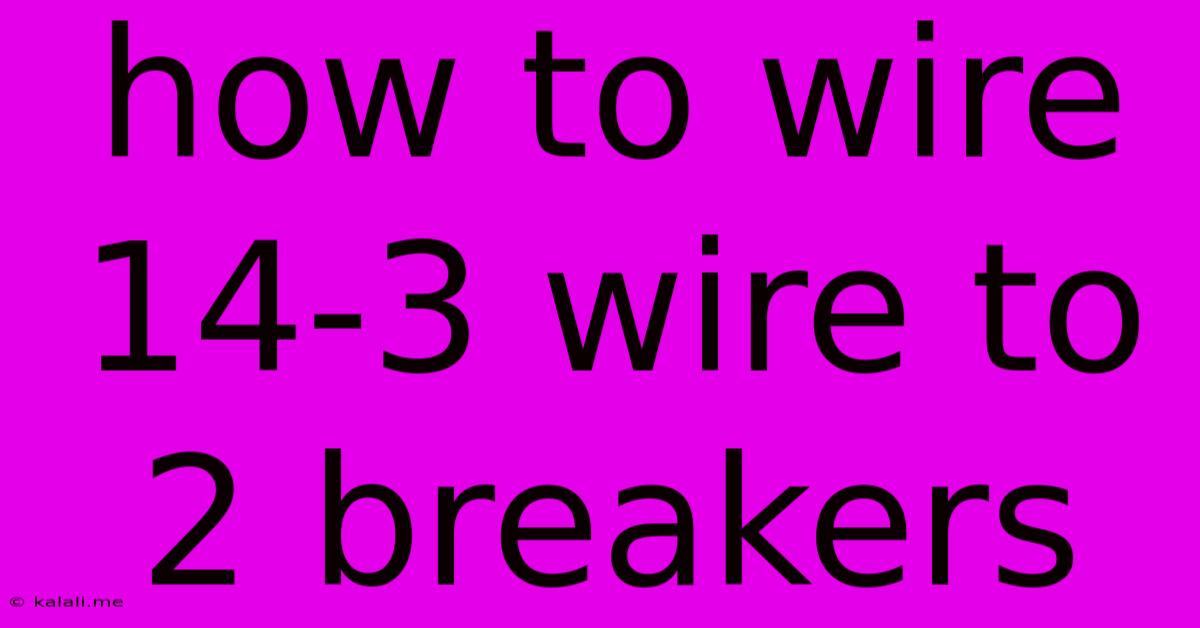How To Wire 14-3 Wire To 2 Breakers
Kalali
May 27, 2025 · 3 min read

Table of Contents
How to Wire 14-3 Wire to Two Breakers: A Comprehensive Guide
Wiring a 14-3 wire to two breakers is a common electrical task, often used for circuits requiring both a switched and unswitched power source, such as a light and a receptacle in a single location. This detailed guide will walk you through the process safely and effectively. Always prioritize safety and turn off the power at the breaker box before beginning any electrical work. Improper wiring can lead to electrical hazards and fire. If you're uncomfortable performing this task yourself, consult a qualified electrician.
This article covers the specifics of connecting a 14-3 wire to two breakers, addressing the common challenges and providing clear instructions. We'll explain the process step-by-step, ensuring you have the confidence to complete this project safely.
Understanding 14-3 Wire and its Applications
A 14-3 wire consists of three conductors: two hot wires (usually black and red), a neutral wire (white), and a ground wire (bare copper or green). The additional hot wire allows for controlling two separate circuits from a single cable run. This is ideal for scenarios where you need both switched and unswitched power at a single location, such as controlling a light fixture and a receptacle independently.
Tools and Materials Required
Before you begin, gather the necessary tools and materials:
- 14-3 Wire: Ensure it's the correct gauge and length for your application.
- Two Circuit Breakers: Match the amperage rating to your circuit's requirements (typically 15 amps for 14-gauge wire).
- Wire Strippers/Cutters: To neatly strip the wire insulation.
- Electrical Tape: To secure wire connections.
- Wire Connectors (Wire Nuts): Appropriate size for the wire gauge.
- Voltage Tester: To verify power is off before and after work.
- Screwdrivers: Phillips and flathead, for working with the breaker box and receptacles.
- Fish Tape (if needed): For running wires through walls or ceilings.
Step-by-Step Wiring Instructions
1. Turn Off the Power: This is the most crucial step. Turn off the power at the main breaker panel to the circuits you will be working on. Use a voltage tester to verify that the power is off.
2. Prepare the Wire: Carefully strip the insulation from the ends of the 14-3 wire, exposing the individual conductors. Leave enough exposed wire for making connections. Be mindful not to nick the copper wires during stripping.
3. Connect to the Breakers: At the breaker panel, identify two empty spaces for your new breakers. Each breaker will control one hot wire.
- Black Wire: Connect the black wire to the terminal on one of the breakers. Secure the connection with a wire nut.
- Red Wire: Connect the red wire to the terminal on the second breaker. Secure the connection with a wire nut.
- White Wire: Connect the white neutral wires from both circuits together with a wire nut. Connect this to the neutral bus bar in your breaker panel.
- Bare Copper/Green Wire: Connect the bare copper or green ground wire to the ground bus bar in your breaker panel.
4. Secure the Connections: Ensure all wire nuts are tightly secured to prevent loose connections. Tuck the wires neatly into the breaker box.
5. Turn On the Power: Carefully restore power at the main breaker panel.
6. Test the Circuits: Use a voltage tester to verify that power is present at the outlets controlled by each breaker.
Troubleshooting and Safety Considerations
- Loose Connections: If the circuits don't work, check all wire connections for tightness. Loose connections can cause intermittent power or even fire hazards.
- Incorrect Wiring: Double-check that each wire is connected to the correct terminal. Mistakes in wiring can lead to malfunctions or electrical shocks.
- Overloaded Circuits: Avoid overloading circuits by connecting too many appliances. Using higher-gauge wire (e.g., 12-gauge) might be necessary for high-power appliances.
Remember, this guide provides general instructions. Always consult local electrical codes and regulations. If you are unsure about any step, consult a qualified electrician. Electrical work can be dangerous if not done properly. Safety should always be your top priority.
Latest Posts
Latest Posts
-
Fire In Oven While Self Cleaning
May 28, 2025
-
How To Fix A Loose Doorknob With No Visible Screws
May 28, 2025
-
Toilets Won T Flush After Heavy Rain
May 28, 2025
-
Google Sheets Count Lines In Cell
May 28, 2025
-
David Changed His Behavior Before Abimelech
May 28, 2025
Related Post
Thank you for visiting our website which covers about How To Wire 14-3 Wire To 2 Breakers . We hope the information provided has been useful to you. Feel free to contact us if you have any questions or need further assistance. See you next time and don't miss to bookmark.